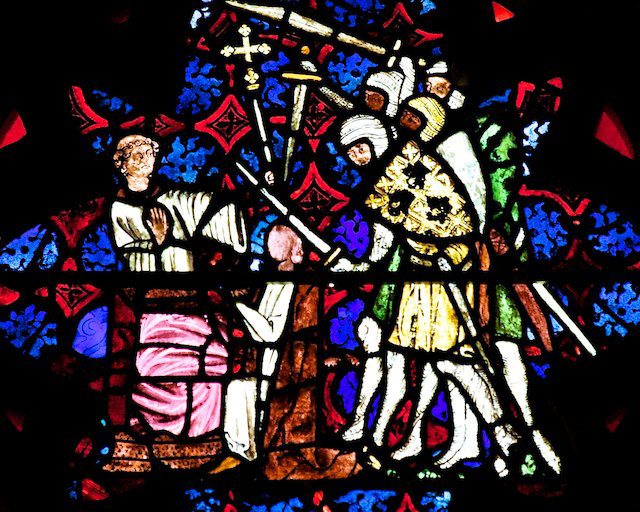Time and Location
MWF 12:50-1:40
Flint 111
Description
The Middle Ages were a formative period in the history of England. Neither that country, nor America would be what they are today without the Middle Ages. Many believe that the Protestant Reformation was the fundamental factor in shaping the national autonomy of Britain. However, a sense of being English came into being in contrast to Vikings. Lovers of liberty and freedom of conscience point to the Glorious Revolution of 1689 as the key event in British history. But the fundamental document at the root of both the constitutional monarchy in Britain and of the American republic is Magna Carta Libertatum, issued in 1215. When interest shifts to the character of the general population of Britain or to the rise of large industrial cities, historians examine the legacy of the Industrial Revolution and the moral ambiguities of Victorian imperialism. Nonetheless, the Middle Ages are not without relevance for what England is today. The Norman Conquest and the Hundred Years War are often invoked as factors to be taken into account when explaining English attitudes towards the French. In both Scotland and Wales, the past has been reinvented recently to provide historical “justification” for the devolution of separate political authorities. In Wales, for example, Edward I’s suppression of the principality of Llewelyn of Snowdonia in 1282 has been falsely represented as an English takeover of the whole of modern Wales. Comparable rewriting of the Irish past from the late 19th century fed the rancor of nationalists insisting that the English had been trying to dispossess the Irish of their original nation as early as 1169. Myth-makers do not care whether their history is sound or not, but historians do. This is where studying the Middle Ages becomes an advantage, given that so much of the symbolism associated with modern political movements and cultural fads, from Scottish independence to British (and American) fascination with the Vikings or Harry Potter, derives from what (truly) happened in the Middle Ages. Historians tend to start the history of medieval England with the Norman conquest, but they do not seem to understand that the first ruler to assume the title of “king of the English” did so almost 200 years before the battle of Hastings. The approach taken in this course is therefore comprehensive: we will cover the whole history of Britain between ca. 400 and ca. 1500.
This course is designed as a chronological and topical introduction to the history of medieval England, from the abandonment of the Roman province of Britannia to the end of the War of the Two Roses. Since this is a survey, it is impossible to cover everything. Instead, the course will offer a selection of representative topics from a much larger possible list. We will examine some of the key political, economic, and social developments that had historical significance, the growth of the Church and its relation to the State, and the growth of urban culture in late medieval England. Our focus will be on England, but we will also take quick glimpses at some neighboring regions (Wales, Scotland, and Ireland), especially in relation to royal policies and power representation. Anyone with enough curiosity and desire to learn is welcome. At least three credits of history (preferably of the Middle Ages) are the pre-requisite for this course.
Textbooks
- Emily Amt (ed.). Medieval England, 1000-1500. A Reader. Toronto: University of Toronto Press, 2018. [hereafter Amt]
- M. T. Clanchy. England and its Rulers,1066-1307. 4th edition. Chichester: Wiley Blackwell, 2014. [hereafter Clanchy; available in electronic format from Library West]
- Miri Rubin. The Hollow Crown. A History of Britain in the Late Middle Ages. London: Penguin, 2006. [hereafter Rubin]
- Barbara Yorke. Kings and Kingdoms of Early Anglo-Saxon England. London/New York: Routledge, 1997. [hereafter Yorke; on two-hour reserve in Library West]
Assignments and grading policy
There is no attendance policy, but you are responsible for attending all lectures and reading the required text, but you are responsible for attending all lectures and reading the required texts. Class participation may be taken into account to determine the overall grade. The basis for evaluation of performance will be four quizzes and two exams (Midterm and Final). The unannounced quizzes are exclusively based on primary source readings from your Amt book and will consist only of multiple-choice questions (no essay). A careful study of these texts is necessary for a good performance at the quiz. The Midterm and Final exams will cover everything from lectures and readings. Both Midterm and Final will consist of two parts: an identification and/or multiple-choice part, and a short essay, in which you will be asked to synthesize your knowledge of the topic, dropping in facts to show that you understand the concrete aspects of that topic. Only the Midterm will be cumulative. In other words, the Final examination will cover only the material since the Midterm examination. Make-up Midterm and Final exam will be given for very serious reasons, in which case you may have to produce some official proof. There is no make-up for quizzes. Extra-credit work will be accepted only for students with active participation in class discussions. The format of the extra-credit option shall be discussed with the instructor during regular office hours. The following point system will be used in determining the final grade:
Quizzes: 40 points
Midterm: 30 points
Final exam: 30 points
Total: 100 points
Grades. The following scale will be used in determining your final grade
| Points | Grade |
| 97-100 | A |
| 93-96 | A- |
| 88-92 | B+ |
| 81-87 | B |
| 75-80 | B- |
| 68-74 | C+ |
| 61-67 | C |
| 55-60 | C- |
| 48-54 | D+ |
| 41-47 | D |
| 35-40 | D- |
| under 30 | E |
